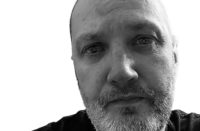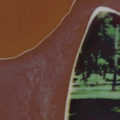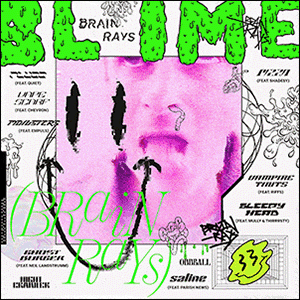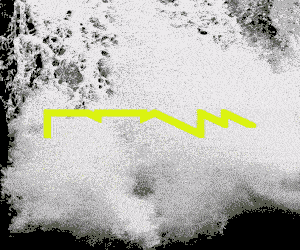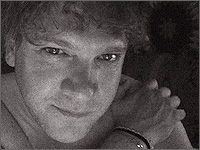
(06.26.06) HOLLYDRIFT‘s first full-length release on
collection of tracks that made up an hour-long radio transmission from
some industrial wasteland still inhabited by the ghosts of the
machinery. Filled with groaning drones, intercepted radio signals,
collapsing gearboxes and furnaces, Waiting For The Tiller was a
collage of noise and atmosphere. Like a wash of white noise and a
crackle of rust and decay, Hollydrift’s music was so unlike “music”
that it could only be classified as an aural experiment. Hollydrift
is synthaesthetic music — your eyes and skin are meant to react to
what your ears hear. But it isn’t nightmares that Anderson is seeking
to create with his otherworldly sonics (this isn’t the terror-stricken
landscape of Sweden’s Cold Meat Industry), but rather evocative
landscapes of abandoned history. Hollydrift recontextualizes the
sounds of the world after they’ve already been forgotten and what we
hear is the lumbering rhythms, the obdurate clatter of machinery and
the crackling voices lost to history.
Recently, Anderson released his
a tune called “Lollipop Power.” It is, as he says on his
has on the subject of noise. Naturally, we weren’t satisifed with
that answer and sought out Anderson to tell us more about the next
phase of Hollydrift’s evolution.
Mark Teppo :: What are you working on how and how is it different
from Waiting For The Tiller?
Mathias Anderson :: Currently, I’m not working on anything. I’d
say I’m putzing around more than actual work. There’s a reason for
this, of course. I have to admit, I’ve grown tired of what Hollydrift
has become. I’m tired of the noise. The loud grinding noise work that
I have been doing lately is troublesome to me. I know a lot of people
hear my music as being some form of soft noise or perhaps tame in
comparison to other noise artists. But really, if you look at songs
like “Midvale Autocall” (from the
EP –ed.) or even “Mary Red Majorette” there’s a strong
component of discord. Both those songs are heavy on saturation,
overdrive, and odd harmonics and have a form of aggression that
disquiets me. I don’t like the images they produce in my mind.
I mean, some of the sounds in the first few minutes of “Midvale
Autocall” are from construction equipment being used to rebuild a mile
of Lake Michigan shoreline by our house. It seems to accomplish the
task, they needed to destroy a lot of the natural shoreline. They were
using some of the largest earth-moving equipment I have ever seen, man
made behemoths that tear the earth apart. I remember I got all
interested in the sound of this equipment and I fired up my recorder.
I wasn’t really thinking too deeply. I just did it and used those
sounds in the recording of “Midvale Autocall” I put the sounds through
an old analog tube amplifier and became enamored with the resulting
output. It was only later, after the song was released, that I
realized I had immortalized the sound of earth and animals and
80-year-old trees being quickly and thoughtlessly destroyed. I mean,
the area where the destruction was taking place had a great deal of
personal meaning for me. Now it’s gone. I found myself a bit sick
about it.
I don’t want to use those kinds of sounds anymore and I’m not going
to. I’m tired of adding to the noise in our society. I want to become
more sensitive to my environment, more inclusive than intrusive. So
to redirect myself, I have produced a cessation: a single called
“Lollipop Power.” It’s the last hoo-ha, the final blast from this
corner of the world. My final statement. My final intrusion…
Mark Teppo :: “This music comes from an old world.” Without asking
you to interpret your music (because, as you say quite clearly on your
website, your intent is simply to create and allow the art to find its
own interpretation in the mind of the listener), can you speak about
what the “old world” is that it drives you to create your music?
Mathias Anderson :: From the industrial revolution onward, we,
as a people, had a lot to listen to. Machines and radio signals became
the norm. Everything clunked and rattled in an organic sort of way.
One of our neighbors grew up near the coal dock in Port. He would fall
asleep to the drone and clank of the manual unloader as it emptied the
cargo of a lake freighter. It would take 24-plus hours in the 1940s to
unload one boat. He said at night he would listen to the rhythm of the
machine, its slow dialog with the atmosphere, a lone voice of metal
and movement.

I can relate. As a kid, I would lay awake on cold winter nights
listening to the gentle sounds of the furnace in the basement, cycling
on, cycling off. The rush of the warm air as it raced through the
vents. The click and snap as the duct work expanded with the sudden
warmth. Anyway, as late as 10 years ago, you could turn on a wide-band
receiver and hear a great number of divergent signals: numbers
stations, utility beacons, radio navigation systems. Mechanical store
signs had a sound all their own. I would go with my dad to the local
liquor store on the weekends. There, I would marvel at the sound of
those beer signs that had scrolling scenes printed on rolled plastic.
The plastic would scrape against the frame in certain spots due to the
heat of the backlight warping them. Also a telephone office had a
festival of sounds in the basement. Telephone technology was very
mechanical up to the 90s. Then there was the sound of malfunction.
If I can take one more trip down memory lane…When I was about seven,
the city I lived in experienced a nasty ice storm. Through a night and
a day, freezing rain fell and coated my suburban neighborhood in three
inches of heavy ice. When the storm was over, no one had power. The
neighborhood grocer could not open. Nor could the gas station or
school. Nothing worked. So the city brought in a power generator. They
placed it on a hill by the school. At some point during the first
night of the generator’s service, it went wacko and shut down. It then
spent the rest of the night attempting unsuccessfully to restart
itself. I could hear it all night chugging to life then sputtering
into silence. A few minutes later, it again heaved to life only to
sputter into silence again. I fell asleep hearing its pathetic yet
valiant attempts to keep us suburbanites warm and with light.
All of these examples and more are the “old world” my music comes
from. Modern times offer us nothing intriguing to listen to. The
airwaves are full of modem grind and rattling data streams. Boring.
All you hear in buildings are fans: cooling, heating, exhaust or
otherwise. Boring. Outside the air is alive with backup alarms, loud
car stereos and idiots on their motorcycles. Very boring. When I’m
creating I try to disavow all knowledge of the modern world. When I’m
building sounds, I always avoid anything that may sound modern or
suggest anything current.
It’s hard to explain. It’s sort of like colors. Certain colors suggest
certain time periods. I try not to use modern colors…the drone at
the end of “A Day Like No Other” is a sound I built from scratch. It
took me several weeks to get it into form. I used a lot of wheezy
outboard gear and some plugs. The result sounds ancient and lonely.
It’s a bit of fun hearing people describe what they think it sounds
like. In the end, surprisingly, many people describe the sound with
emotional syntax. It’s an old, old sounding thing, that’s for sure. I
received an email awhile ago where the guy said that particular drone
sounded like something you’d hear in an old factory after it had been
abandoned for 50 years. I think that’s spot on.
Mark Teppo :: How do your tracks come about? Is it a sequence of
sounds that creates that germinal seed? Is it the title? or a desire
to experiment with sound?
Mathias Anderson :: It is, without question, a desire to
experiment with sound. All of what I do is the result of my
fascination over what sound is, what can be done with a sound, how it
can be manipulated and changed. It’s all so amazingly flexible. I see
visuals when I hear sounds. I think everyone does. A sound an be an
asphalt road. A sound can be the moon. Unfortunately, structured music
as a whole has departed the sound arena. The thrill is gone. Everyone
raves about the John Bonham drum sound, but all anyone can do is ape
the John Bonham drum sound. No one can think up anything new on their
own. It’s just mimicry. That’s all music is now. At some point, music
stopped evolving. Year after year, bands come out doing nothing more
than trying to out-bad ass the world. On the other side are a bunch of
bands trying to out-bland the world. A certain sent of frequencies are
used by each camp. That’s it. Music and sound have become as boxed in
as our personalities I mean, how many covers of “Big Yellow Taxi” do
you suppose you’ll have to endure in a lifetime? And how long will
people continue to buy Beatles CDs instead of choosing to evolve. To
evolve musically, you need to move forward. You need to stop buying
Beatles CDs.
Anyway, I don’t make music. My tracks come about in different ways.
Sometimes I’m just messing about with samples and plugs; just to see
what happens. Other times, I’m looking for a specific sound, something
I need. If I can’t find it, I build it myself. I try not to lock
myself down to one mission. It’s the idea that the sounds are in
charge. I can’t sketch it like a painter would. My work is based on
abstracts and vastly divergent variables. My mood at the time of
writing rarely has any impact on the final result, there’s something
deeper going on. Once I have an atmosphere created, the song is
finished. Then I dig through my title list and find an appropriate
moniker. It’s really very simple. I have no choice but to work until
the piece is complete. Where that takes me or how long the process
might go on is anyone’s guess.
I will admit that I am haunted by the past on an extreme level. The
what-used-to-be and the how-it-was really do a number on my head. When
I see an old empty house or an abandoned factory or old machines or
whatever, I just fall into a funk that I can rarely shake. Antique
stores drive me loony sometimes. Everything from 1940 to 1970 gnaws at
me. Not world events from those times but the little things, the long
ago things, the things still lying in fields or gathering dust in
attics. Abandoned sandboxes just cry to me. People say the imagery
that comes up in their minds when they listen to Hollydrift is of the
old, the forgotten, and the no longer needed. It’s safe to say what
haunts me cannot be hidden in my work. I work in almost complete
darkness, I’m in a dark, safe place and I just let things happen. It’s
just the sounds and God and me.
Mark Teppo :: How do you think you’ll approach sound now? More
meditative organic rhythms? A Hollydrift re-creation of bird song?
Have you considered turning inward like Daniel Menche and Aube have
done and use the sounds the human body makes for the basis of your new
work? Sort of like going inside an anechoic chamber and listening to
your body make noise.
Mathias Anderson :: That’s a very interesting thing for an
artist to do. Sort of like biofeedback? I wouldn’t have a clue how to
turn inward to that extent. Lack of light for me simply abates
chronological awareness. In such a state, I could be occupying any
number of cool places in 1952. As much as I like nature and weather,
I’m still irrevocably drawn to sounds made by objects made by humans.
It’s so hard to predict art. I thought today I should buy an acoustic
guitar. I wasn’t thinking melody or angst-ridden singer songwriter
tripe. I was thinking about all the amazing nonmusical sounds you can
get from that type of instrument. Yes, as you say, my approach will be
much more meditative. And why not? My entire life is becoming more
meditative. I mean, I get up in the middle of the night and watch my
daughter sleep. Even though she’s 24-years-old and no longer a child,
it’s still meditation. I want to be the converse. I want to make
sounds that won’t disturb. Besides, we have enough Merzbows and
Squarepushers to add to the din. If you’re all angry and pissed off,
there are thousands of screamo bands that will add to your misery,
even though you tell yourself they help you. I really want to add to
the quiet. I want Hollydrift to be an addition, not domination. Does
that make sense, to want to make sound and not be a sledge hammer?
Mark Teppo :: You have a number of streaming sounds on your site
that seem to be very evocative of the field noises that you include in
your work. What fascination do these sounds hold for you? Would you
classify them as “ambient” in the traditional Eno sense (“aural
wallpaper”)?
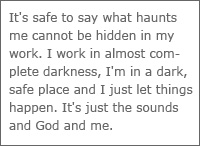
Mathias Anderson :: I would say they are definitely not
wallpaper. I have placed sounds on the ‘Listen’ page because I think
they need to be heard. Certainly
Tippet’s last contact with dispatch is an important thing to hear
but that’s not my recording of it. Also, the mundane things on the
page are important, too. As far as my personal work, the field
recordings I use are collected by me. I never use any movie/TV dialog
or sounds in my work. There is nothing generated from the
entertainment industry in my work. I have also left the Internet
Archive’s Prelinger Archive alone as well. Everything is from what I
have recorded or from what I have found in an empty building or stale
cellar. When you hear the speech or sound that comprises my songs,
it’s from my exclusive estate of collected sounds. All the sounds I
use are from that same collection — mine. I carry an MD recorder all
over the place. I record and archive the sounds that touch me. I make
an idiot out of myself in public because I look like some touched
blighter standing there recording something. I’ve earned these sounds.
They are mine.
Mark Teppo :: You’re planning on re-releasing Waiting for the
Tiller in mono, citing the reason as being so that “we can live in
the days of old and hear how Hollydrift would have sounded in 1948.”
Mathias Anderson :: The reason I want to offer my releases in
mono versions is another attempt to hang on or otherwise give modern
voice to the past. I believe there is a lot to a mono signal. No one
hears anything in mono anymore. When a modern song is mastered, the
dynamic range is blasted into oblivion by compression and then the
stereo field gets hyper spread. What you end up with is a really
crappy end result that sounds like you’ve hooked up your speakers out
of phase. Then the radio stations add more compression on top and hype
the stereo field even more. What a mess.
With a mono signal, everything is right there at the center of both
speakers. It takes up residence in an area completely abandoned by
modern music. A mono signal builds a home in a land the modern world
has abandoned. It’s an interesting thing to listen to if you really
give it a chance. All sounds coming from one place. All the sounds
piled together. Mono is the sound heard from table top radios in the
1950s. Mono is the sound heard from car radios of long ago, from
transistor radios in the 1970s. I can’t imagine how Hollydrift will
sound in mono because I have yet to convert the 2 cds, but I think it
will be fascinating…
Mark Teppo :: We don’t have shortwave radio now like we did then,
certainly not the proliferation of things like the numbers stations
and strange bounced signals from far away. Have we lost some sense of
ourselves with the Clear Channel ideology of jamming the radio waves
with talk, talk and more talk? Are we even more alone now with our
radios?
Mathias Anderson :: Lost some sense of ourselves? We lost that
a long time ago. Clear Channel has figured that out and is cashing in
on the fact that we have allowed ourselves to become enslaved to the
entertainment industry. Clear Channel knows you can’t turn off the TV
or radio. They know that you’re going to talk to your friends about
what so-and-so said and your enthusiasm is going to generate millions
of dollars in advertising revenue for them. Not you, them.
I invite anyone, right now, to ook at the clothes you’re wearing. How
many multimillion dollar corporation logos are draped across your
body? Did you know that if the same corporation wanted to do the same
type of ads on TV, they would have to spend millions to do it? Yet,
YOU paid for that Harley Davidson t-shirt your wearing. Your
hard-earned money paid for the Tommy Hilfiger logo you have emblazoned
across your chest. Americans have become walking billboards for
corporate America and they don’t even know it. It’s time you start
thinking, America. It’s getting late. Mono. That’s really were it’s
at. There’s so much to hear in mono. Mono becomes a mood, an
atmosphere. Very cool.
Mark Teppo :: Your new summer single represents a summation of what
you have been seeking with your sound until this point. Where do you
go now? Is the creative desire gone, now that you have created
something that satisfies you?
Mathias Anderson :: You’re right, the last 3 minutes or so of
‘Lollipop Power’ are the sum total of my work to this point. Those
minutes are closure for me. I have become hyper-sensitive to sound
over the last 3 or so years. I’ve finally seen the correlation between
sound and spiritual health. At Hollydrift shows, I’ve heard
exclamations and seen clenched fists. Yet during sets by more mellow
ambient artists, I’ve seen people stand in the middle of the crowd
with their eyes closed, listening, transfixed. I don’t want to make
people clench their fists. I want to make music that will nurture
their inner lives, advance their quiet selves. Where do I go from
here? I don’t know. I still want to do sound collages and work with
found sounds. However, my work from here on out will be mellow.
I’ve also started painting. I’ve just started on my first picture.
Actually, all my paintings will be abstract. I feel I can express more
with abstract, just like my music. So, this should be interesting.
I’ll be working with oils…
Mark Teppo :: You are collaborating with
your first collaboration? How does his different sound/approach
stretch your creative process? Is it having an effect on how you view
your future work?
Mathias Anderson :: Yes, this will be my first collaboration.
What he does, I could never do. He has all this stuff in his studio,
pedals, bass, guitar, delays, and an old MC-202 and he composes
improvisationally. He starts the tape rolling and starts playing. My
method is experimenting with relationships and mapping. Mine has a
little more academic thought put into it, where he just goes straight
from the heart to his instruments. I like his method better, it make
more sense viscerally speaking. But I can only create the way I
create. The same goes for him. So, it should be an interesting blend.
I have played with him before with some interesting results. He had
started to play in and around my music while I was rehearsing my live
set. I liked how it sounded. I really like what he does.
Mark Teppo :: Outside of the collaborative work, what has influenced
you, musically? Outside of music?
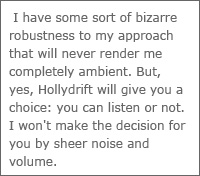
Mathias Anderson :: Absolutely nothing has ever influenced me
musically. Outside of music, it can be anything. A machine or a sign
creaking in the wind. I’m mostly drawn to sounds that call from
another age. I also actively seek out sounds that have been around a
long time. I don’t ever really know how to answer this question. I
like lonely sounds and bizarre sounds. The street cleaner in the town
where I live comes around every week or so. I don’t know its schedule
so I’m always caught unprepared, but I really want to get that machine
on tape. It has a very strange sound to it — almost like a mellotron
doing low string chords. It’s a warbled drone. Very weird hearing it
come up the street. Little things like that get my attention but they
are few and far between. As the world gets smaller and everything
becomes standardized, the sounds we hear become much less exciting.
So, I do try to listen for the in-between sounds. The sounds that
almost aren’t there. At my day job we use two-way radios on an EDACS
trunking system. I’ve noticed that our key-offs very each time we end
a transmission. I’ve been thinking I should collect an hour or two of
key-offs…
Mark Teppo :: Is this where creation still exists, in these
in-between sounds? Is this where chaos makes beauty and we still have
a chance to be individuals, in these tiny spaces between the vast
noises of homogenized society? Is the act of artistry now not an
effort to make a noise loud enough to drown out the world, but gentle
and fragile enough to fit in between where only those who care enough
to listen will here it? It would seem that the relationship between
you and the listener will become something more intimate, where
instead of hitting them with a large sound that they can’t avoid, they
have to want to hear your sounds. It’s a participatory experience
instead of a receptive one.
Mathias Anderson :: Precisely! The only place you can be an
individual is in the space between the TV show and start of the TV
commercial. Between the movie theatre and turning on the car radio.
The space between billboards, the moments after a door closes. It’s
all interlocking. Corporate America wants to keep you distracted by
noise. So many sounds and images bombarding you that you have no clue
what’s going on or who’s sifting through your wallet. Corporate
America is using military tactics to neutralize you so they can take
your money. It’s like bricks of sound. I’m so very tired of them.
When we go to a restaurant the background music is so loud that the
patrons become the background while the music rains dominant. How many
times have you had to shout over the din of some moron, with a
super-loud stereo in his car, coming through town forcing his musical
tastes on you? Yet if you say “Jesus loves you” to the same person,
he’ll indignantly advise you not to shove your religion down his
throat. Asinine.
I think you’re absolutely right. If I make music that’s fragile and
breakable, it will become part of the in-betweens I’ve been referring
to. I don’t think I’ll make music that breakable. I have some sort of
bizarre robustness to my approach that will never render me completely
ambient. But, yes, Hollydrift will give you a choice: you can listen
or not. I won’t make the decision for you by sheer noise and volume.
Mark Teppo :: Does the name Hollydrift still work for you or is the
closure hard enough that the name is being laid to rest as well?
Mathias Anderson :: No, this can be considered a soft closure.
To be perfectly honest, when I settled on the name Hollydrift, I
really thought I’d be making music so far back as to be unnoticeable.
I was wrong. The name Hollydrift still brings forth a whimsical,
blue-eyed, baby soft little girl image. It’s an ironic name, in the
face of what my output has been recently. I want to quit that. I want
to get to know that baby soft little girl. And I will, eventually. (END)
For more info about Hollydrift and Parasomnic, visit hollydrift.com and parasomnicrecords.com.








